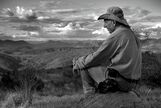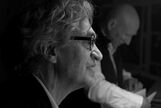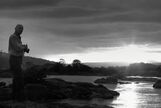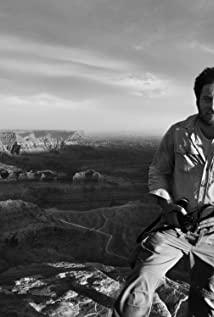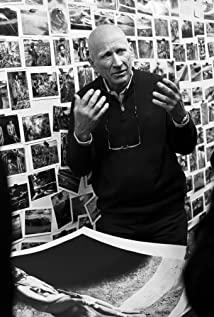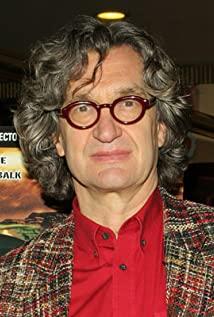The salt of the earth comes from Jesus' description of Christians in the Bible, "You are the salt of the world. If the salt loses its taste, how can it be made salty again?" Jesus compared people to salt because he hoped that his followers could purify quality of the world. I think this is also Salgado's expectation for moviegoers, hoping that they can see the darkness and hardships of this world clearly, and at the same time reflect on themselves, pay more attention to and help those souls who are going through torment. The entire film uses black and white tones, with a large number of still photos running through it, accompanied by Salgado's low and charming French, which seems to be relaxed, but always conveys the theme of serious grief - "There is a kind of sadness in the world. The beasts are the most terrifying, and that is us humans." Sebastian Salgado is a humanitarian photographer who was born in a small town called Almo Khan right in the center of Brazil. As a young boy, Lilia from the Conservatory came into his life and supported him throughout the decades of his wandering photography career. He had a promising and lucrative job, but when he went to Mozambique and Angola as a consultant to the World Bank and saw the hardships and exploitation that many people in the countryside were experiencing, he decided to use photography to show the world what he was witnessing. He quit his job and used all his savings to buy various photographic equipment. After everything is zero, travel all over the world, measure the width of life with footsteps, and explore the true meaning of human beings with the lens. He seems to be a bystander, using his camera to record every moment of grief, indignation, pity, and shock. In fact, he is also an experiencer, bearing the pain and devastation in the picture together with the subject. The first scene of the film is the famous Serra Pelada gold mine in Brazil. Tens of thousands of people are carrying heavy sacks, stepping on simple ladders, and "crawling" in the huge mine to perform slave labor. . Among them were farm workers, intellectuals, and clerks working in cities. Out of the thirst for wealth, once everyone embarks on the road of gold rush, there is no turning back. They are ragged and frail, and they travel between steep rocks all day long, and they may fall into the abyss at any time, shattering their bones, and even bringing the gold diggers behind them. However, none of this can stop their craving for material things. In 1977, Salgado, who received funding, started his first major filming project, "Another America." He spent a happy time with the alcoholic Saraguro, where he was believed by Pella the Saraguro to be a man sent by God to observe all beings. As a result, he also received the kindest blessing in the world - "I judge that you will definitely go to heaven in the future". Living there made him experience a different way of thinking and a rhythm of life than usual. Later, he came to a peasant tribe in Oaxaca, Mexico, where people lived a traditional and ancient life, and they loved music very much. If a person can play an instrument, then he does not need to work and can concentrate on studying music. After a period of testing, he integrated into it and became a member of the tribe. The shooting here made Salgado realize, "To take a portrait of a character is not as simple as taking a photo, but to present and express the emotions and thoughts of the characters in the film." Let the world begin to notice the different lives of another group of people under the same sky. In 1984, Salgado took refugees as subjects for a series of photographs titled "The Sahel - Sad Humans". One of the photos that impressed me the most was that of Salgado and the refugees running as they evaded a helicopter attack. In the picture, a woman with a terrified look stared at her and turned her head to look at the back in horror. An ignorant child was next to her. The child may not know what happened, but just ran away with her mother for unknown reasons. Perhaps the sound of the cannonball was so familiar to a child that he didn't have the nervous and frightened expression on his face like his mother's. The scene changes, and another photo shows the refugees shrouded in poverty and starvation, skinny and lifeless, and death has become a part of their daily life. "Their faces look young, but the disease makes them look old." "What really makes people feel old is their empty eyes," Salgado said sadly, looking at the photo: "I long for Showing these pictures tells the world that there are so many people here who are in great misery." Photographer in Greek means someone who paints the world with light, and Salgado not only did that, he was a great photographer. For decades, regardless of his own life, interests and reputation, he has ventured deep into the dangerous areas where countless people want to escape. The camera is his weapon, the lens is his sharp edge, and he is single-handedly fighting against the darkness and injustice of the world. Fortunately, his hard work and dedication were not in vain. Once published, photographs, books, and exhibitions immediately grabbed the public's attention, sparking discussions about human living conditions today and the real reasons for this. For those who were photographed, I think Salgado's shooting brought them hope and the right to speak. Although the photo is just a static picture, their eyes, expressions and state all tell the helplessness and grief in their hearts - born as human beings, everyone is equal, why do we have to suffer this nameless pain, the evil result of this political struggle. Their silent complaints shouted to the world through Salgado's camera, the pain they were carrying was conveyed through Salgado's photos, more and more people called on the government to stop the war, and more and more non-profit organizations rushed to Dangerous areas, bring them drinking water, food, medical resources. In this battle using cameras, lenses, and photos as weapons, Salgado has undoubtedly succeeded. But after countless times witnessing human beings kill each other and self-destruction, and after countless times as an empathic experiencer, he used a camera to freeze corpses, killings, diseases, and escape. He became ill, not physically, but his soul. After experiencing the darkness of the world, he began to question his photography projects and his role in this human activity. In the end, he put down the camera in his hand, returned to his hometown, rebuilt the forest, and found comfort in nature. I admire Salgado's legendary life. I admire his courage, his kindness, his dedication, and his perseverance. He is not only the man who paints the world with light, but also the conscience of mankind, the salt of the earth. For those who were photographed, I think Salgado's shooting brought them hope and the right to speak. Although the photo is just a static picture, their eyes, expressions and state all tell the helplessness and grief in their hearts - born as human beings, everyone is equal, why do we have to suffer this nameless pain, the evil result of this political struggle. Their silent complaints shouted to the world through Salgado's camera, the pain they were carrying was conveyed through Salgado's photos, more and more people called on the government to stop the war, and more and more non-profit organizations rushed to Dangerous areas, bring them drinking water, food, medical resources. In this battle using cameras, lenses, and photos as weapons, Salgado has undoubtedly succeeded. But after countless times witnessing human beings kill each other and self-destruction, and after countless times as an empathic experiencer, he used a camera to freeze corpses, killings, diseases, and escape. He became ill, not physically, but his soul. After experiencing the darkness of the world, he began to question his photography projects and his role in this human activity. In the end, he put down the camera in his hand, returned to his hometown, rebuilt the forest, and found comfort in nature. I admire Salgado's legendary life. I admire his courage, his kindness, his dedication, and his perseverance. He is not only the man who paints the world with light, but also the conscience of mankind, the salt of the earth. For those who were photographed, I think Salgado's shooting brought them hope and the right to speak. Although the photo is just a static picture, their eyes, expressions and state all tell the helplessness and grief in their hearts - born as human beings, everyone is equal, why do we have to suffer this nameless pain, the evil result of this political struggle. Their silent complaints shouted to the world through Salgado's camera, the pain they were carrying was conveyed through Salgado's photos, more and more people called on the government to stop the war, and more and more non-profit organizations rushed to Dangerous areas, bring them drinking water, food, medical resources. In this battle using cameras, lenses, and photos as weapons, Salgado has undoubtedly succeeded. But after countless times witnessing human beings kill each other and self-destruction, and after countless times as an empathic experiencer, he used a camera to freeze corpses, killings, diseases, and escape. He became ill, not physically, but his soul. After experiencing the darkness of the world, he began to question his photography projects and his role in this human activity. In the end, he put down the camera in his hand, returned to his hometown, rebuilt the forest, and found comfort in nature. I admire Salgado's legendary life. I admire his courage, his kindness, his dedication, and his perseverance. He is not only the man who paints the world with light, but also the conscience of mankind, the salt of the earth.
View more about The Salt of the Earth reviews



